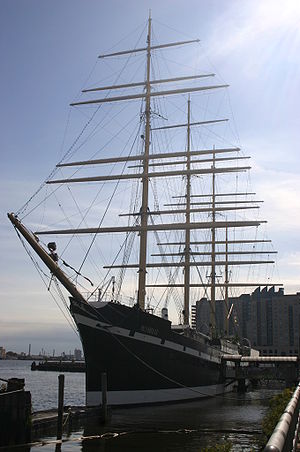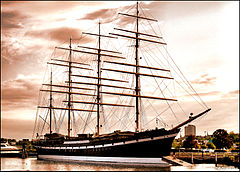- Moshulu
-

The Moshulu at Penn's Landing, PhiladelphiaCareer 
Name: Moshulu ex Kurt Namesake: Dr. Kurt Siemers (to Kurt) Owner: G. H. J. Siemers & Co., Hamburg Route: (GE) Europe to Chile and Newcastle, Aust.
(FI) Australia to Europe grain trade
(US) Manila, Australia, SouthafricaBuilder: Alex. Wm. Hamilton & Co., Port Glasgow Cost: £36,000 Laid down: 1903 Launched: 18 April 1904 Christened: 18 April 1904 as the Kurt Completed: June 1904 Decommissioned: 1970 Maiden voyage: June 1904 via Santa Rosalía to Valparaíso Reinstated: 1935 as a cargo ship, 1975 as a restaurant Homeport: Hamburg, San Francisco, Mariehamn, Philadelphia Status: restaurant ship General characteristics Class and type: four-masted steel barque
cargo ship, fl. warehouse, restaurant shipDisplacement: 7,000 ts (1,700 ts ship + 5,300 ts cargo) Length: 396 ft (121 m) (overall)
359 ft (109 m) (on deck)
335.3 ft (102.2 m) (btw. perpendiculars)Beam: 46.9 ft (14.3 m) Height: 212 ft (65 m) (keel to masthead truck)
185 ft (56 m) (main deck to masthead truck)Draft: 24.3 ft (7.4 m) at 5,300 tons Depth: 28 ft (8.5 m) (depth moulded) Depth of hold: 26.6 ft (8.1 m) Decks: 2 continuous steel decks, poop, midshipbridge and forcastle decks Installed power: no auxiliary propulsion; donky engine for sail winches, steam rudder Propulsion: wind Sail plan: 4.180 m²; 34 sails: 18 square sails, 3 spankers, 13 staysails Speed: 17 knots (31.48 km/h) Boats and landing
craft carried:four lifeboats Complement: max. 35 Crew: 33 (captain, two helmsmen (1st & 2nd mates), 1 steward, 29 able seamen) Moshulu (ex Kurt) is a four-masted steel barque built by William Hamilton on the River Clyde in Scotland in 1904, and currently a floating restaurant docked in Penn's Landing, Philadelphia.
Contents
History
Originally named Kurt after Dr. Kurt Siemers, director general and president of the Hamburg shipping company G. H. J. Siemers & Co., she was, along with her sistership Hans, one of the last four-masted steel barques to be built on the Clyde, (Archibald Russell was launched in 1905). Constructed for G. H. J. Siemers & Co. to be used in the nitrate trade, at a cost of £36,000, she was launched in 1904. Her first master was captain Christian Schütt, followed by captain Wolfgang H. G. Tönissen in 1908 who made a fast voyage from Newcastle, Australia, to Valparaíso with a cargo of coal in 31 days.
Between 1904 and 1914, under German ownership, Kurt shipped coal from Wales to South America, nitrate from Chile to Germany, coal from Australia to Chile, and coke and patent fuel from Germany to Santa Rosalía, Mexico.
On the outbreak of World War I in 1914, Kurt was sailed to Oregon in command of captain W. Tönissen, then laid up in Astoria until being seized when the United States entered the war in 1917. She was first renamed Dreadnought ("one who fears nothing"), then, because there was already a sailing ship of that name registered in the US, she was renamed the Moshulu (which had the same meaning in the Seneca language) by the First Lady of the United States and wife of President Woodrow Wilson, Edith Wilson. Between 1917 and 1920, Moshulu was owned by the U.S. Shipping Board and carried wool and chrome between North America, Manila and Australia.
From 1920 to 1935, Moshulu was in various private hands based in San Francisco. From 1920 to 1922, it was owned by the Moshulu Navigation Co. (Charles Nelson & Co.), San Francisco; in 1922, it was sold to James Tyson of San Francisco; and, in 1922, it was repurchased by Charles Nelson. The big four-masted barque ran in the timber trade along the U.S. west coast to Australia and South Africa from 1920 to 1928. After her last timber run to Melbourne and Geelong, Australia, in 1928, she was laid up in Los Angeles; later on, she was kept in places in or near Seattle, Washington: Lake Union, Winslow on (Puget Sound), and Esquimalt in British Columbia, Canada 100 nautical miles (190 km) north west of Seattle).
In 1935, the Moshulu was bought for $12,000 by Gustaf Erikson. On 14 March 1935, when the contract was signed, captain Gunnar Boman took over the ship and sailed it to Port Victoria. Gustaf Erikson had her operate in the grain trade from Australia to Europe. In 1937, John Albright sailed on her as a young seaman. During the period of Erikson ownership the working language of the ship was Swedish, even though it sailed under the Finnish flag. The ship's home port at the time, Mariehamn, is in the Swedish-speaking Åland Islands of Finland.
The ship was seized by the Germans in 1940 when she returned to Kristiansand, Norway, with a cargo of wheat from Buenos Aires under the command of Captain Mikael Sjögren. She was derigged step-by-step in the 1940s, and, after having capsized in a storm close to shore in a beach near Narvik in 1947, she was demasted by a salvaging company to be re-erected, stabilized, and towed to Bergen in July 1948. The ship's hull was sold to Trygve Sommerfeldt of Oslo. A few months later, the ship was transferred to Sweden to be used as a grain store in Stockholm from 1948 to 1952. Then she was sold to the German shipowner Heinz Schliewen, who wanted to put her back to use under the name Oplag as a merchant marine training ship carrying cargo.[1] Schliewen already used the four-masted steel barques Pamir and Passat (both former Flying P-Liners) for that purpose, but before Moshulu was re-rigged, Schliewen went into bankruptcy. In 1953 Moshulu was sold to the Swedish Farmers' State Union ("Svenska Lantmännens Riksförbund") of Stockholm, and again it was used as a floating warehouse beginning on 16 November 1953.
In 1961, the Finnish government bought the ship for 3,200 tons of Russian rye; she was towed to Naantali, a town near Turku, and she continued to be used as a grain warehouse.
In 1970, the ship was bought by the American Specialty Restaurants Corporation, who rigged her out in Holland with phony masts, yards, and lines and eventually towed her to South Street Seaport, New York City. Other sources have it that The Walt Disney Company bought the ship but soon transferred it to the American "Specialty Restaurants Corporation".
Moshulu's fame through Eric Newby
Moshulu is famous through the books of Eric Newby. At the age of 19, he apprenticed aboard the Moshulu. He joined the ship in Belfast in 1938, sailing to Port Lincoln in Australia in 82 days with a load of ballast stone, a good passage for a windjammer. They took 4,875 tons of grain on board in Port Victoria and sailed back in the spring of 1939 to Ireland, beating a number of other sailing ships with a passage of 91 days. During this time, Newby took part in all the tasks necessary to run and maintain the ship, such as constant chipping of rust and painting of the ship, changing from storm sails to fair weather sails and back again, and perpetual overhaul of the standing and running rigging - all of this on top of the day-to-day tasks of sailing the ship. The crew at the time was predominantly Finnish and Swedish, and nationality was a source of friction amongst the crew throughout the voyage.
The journey was documented in Newby's books The Last Grain Race (1956) and Learning the Ropes: An Apprentice in the Last of the Windjammers (1999), the latter being a book of photographs he took while aboard. The title of the 1939 book refers to the last grain race before the outbreak of World War II. While windjammers exist and sail the seas to this day, the last windjammer carrying cargo was the Peruvian Omega (ex Drumcliff) which was in use until her loss in 1958.[2]
Moshulu, like all grain ships, was lightly manned - during Newby's time on the ship the total crew was only 28 strong, including 4 officers, the cook, the steward, and 8 sailors in each of the port and starboard watches. Routine tasks such as wearing the ship required every single last crew member to be involved, meaning lost sleep for the free watch. If a sailor became ill or injured, chances were slim that he would receive treatment on shore, especially since Moshulu made no stops between Europe and Australia during Newby's voyage. When a man like Newby applied for a position in the crew, the captain had him climb to the top of the mainmast, pointing out that at sea he might have to climb it while it was swaying wildly. For many applicants that was enough; they were never seen again.
Moshulu today
The Moshulu was seen in the movies Rocky (shown during one of Rocky's workout sessions along the waterfront) and The Godfather Part II (bringing the young Vito Corleone to America in 1901, two years before it was built), as well as in the end scene of the movie Blow Out. The ship is now a restaurant at Penn's Landing, Philadelphia, where it is docked adjacent to the museum ships USS Olympia and USS Becuna. The restaurant's cuisine is a fusion of Southwestern, American, and French, with a South Seas flair.[3] The Moshulu also includes the Bongo Bar deck on the upper level.
See also
Four other Clyde-built tall ships are still afloat:
For examples of other large sailing ships:
References
- ^ Underhill, Harold A. (1956). Sail Training and Cadet Ships. Glasgow: Brown, Son & Ferguson. pp. 145–7.
- ^ Wilhelmsen, F D (1956). Omega: Last of the barques. Westminster, MD: Newman Press. http://books.google.com/books?id=yAIYAAAAIAAJ&pg=PA109&dq=omega+barque&lr=&num=100&as_brr=4&cd=1#v=onepage&q=omega%20barque&f=false.
- ^ Eberz, Megan; Grims, Martin; Meglino, Diane. ".:: Moshulu Restaurant & Bar ::.". Moshulu Restaurant & Bar. http://www.moshulu.com/site/main.asp. Retrieved 2010-07-19.
Further reading
- Newby, Eric, The Last Grain Race, Secker & Warburg, London, 1956; Penguin Books, New York, N.Y., U.S.A., 1986. ISBN 0-140-09571-3 (pbk.)
- Newby, Eric, Learning the Ropes - An Apprentice in the Last of the Windjammers, John Murray, London 1999. ISBN 0-7195-5636-8
Further referencies Sven-Erik Nylund: Inte rädd för någon, Vasa 2001, Schildts ISBN 951-50-1195-7 (inswedish)External links
Coordinates: 39°56′32.5″N 75°08′28″W / 39.942361°N 75.14111°W
Categories:- Barques
- Windjammers
- Grain ships
- Individual sailing vessels
- Tall ships of the United Kingdom
- Tall ships of Germany
- Tall ships of Finland
- Tall ships of the United States
- Four-masted ships
- Clyde-built ships
- Cuisine of Philadelphia, Pennsylvania
- Restaurants in Philadelphia, Pennsylvania
- 1904 ships
Wikimedia Foundation. 2010.

